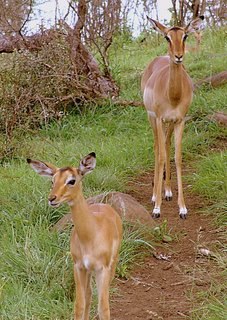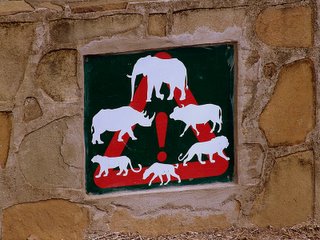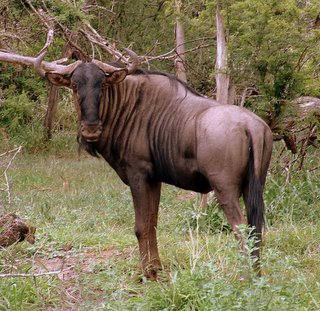We had dinner on Saturday evening at Alfredo’s, an Italian restaurant located in a complex of small apartments, and sat outside near the pool. Cuisine is not a priority in St. Lucia, which undoubtedly explains the presence and popularity of the Ocean Basket, but Alfredo’s did a passable pasta. While sitting outside we were visited by a rather friendly cat and when Hubby inquired if it was the restaurant’s cat, the server replied “Oh, no…this is St. Lucia’s cat!” Rather than find feral cats a scourge, as we seem to do in America, the town of St. Lucia has adopted these homeless cats, allowing them to roam freely through the outdoor restaurants and holiday accommodations. We met at least five cats during our stay, all of whom were friendly communal cats, well fed, friendly, and a delight to the tourists.
Gavin had suggested that we go to Imfolzi or Hluhluwe, game reserves across the highway from St. Lucia, if we wanted to see elephants and rhino, their local brethren having been rather shy with us. So, early the next morning we rose to a breakfast of pineapple and orange juice, loaded up Bertha…which had acquired the nickname “Dirty Bertie” by this time…with cold drinks and snacks, and headed for Hluhluwe (“shuh-SHLU-wee”). As it turned out, Gavin had given us an excellent suggestion. Almost immediately upon entering the park, we met up with a giraffe having an early breakfast. Ignoring us as if we were not even there, he browsed the top of a stickery acacia tree, calmly chewing and looking as if he hadn't a care in the world. I've seen giraffe in zoos...the San Diego Zoo is one of the finest in the world and I have been there more times than I can remember...but nothing prepared me for seeing this long-necked giant nonchalantly chewing the top off a tree from the side of a road! Encountering him had been quite a surprise ad we had not expected to find wildlife within minutes of entering the reserve, but we drove around a curve in the road and there he was!
As it turned out, Gavin had given us an excellent suggestion. Almost immediately upon entering the park, we met up with a giraffe having an early breakfast. Ignoring us as if we were not even there, he browsed the top of a stickery acacia tree, calmly chewing and looking as if he hadn't a care in the world. I've seen giraffe in zoos...the San Diego Zoo is one of the finest in the world and I have been there more times than I can remember...but nothing prepared me for seeing this long-necked giant nonchalantly chewing the top off a tree from the side of a road! Encountering him had been quite a surprise ad we had not expected to find wildlife within minutes of entering the reserve, but we drove around a curve in the road and there he was! At the entrance gate, when he paid our fees, Hubby bought a map book that turned out to be invaluable. Not only did it show the various roads and view spots in the park, the back of the book contained excellent drawings of the resident animals, enabling us to identify many of the creatures we sighted. Impala...the antelope after which one of Chevrolet's most successful models was named...are tiny little creatures! I had expected a larger, bolder, more impressive looking animal, so the slightness and delicacy of their body structures really surprised me. They are reputed to be shy animals, but the were the single most common species we encountered and while I wouldn't call them exactly friendly, they were not easily spooked. We came across this cautious mother and curious baby as part of a larger herd.
At the entrance gate, when he paid our fees, Hubby bought a map book that turned out to be invaluable. Not only did it show the various roads and view spots in the park, the back of the book contained excellent drawings of the resident animals, enabling us to identify many of the creatures we sighted. Impala...the antelope after which one of Chevrolet's most successful models was named...are tiny little creatures! I had expected a larger, bolder, more impressive looking animal, so the slightness and delicacy of their body structures really surprised me. They are reputed to be shy animals, but the were the single most common species we encountered and while I wouldn't call them exactly friendly, they were not easily spooked. We came across this cautious mother and curious baby as part of a larger herd. The juvenile bucks engage in mock battles, practicing for the day they will challenge other bucks for mating rights. We drove over series of hard-packed dirt roads, watching for game and, cresting the top of a hill, we spotted a herd of perhaps fifty impala spread out across a rolling meadow. In one swale three pairs of young bucks were hard at work honing their fighting skills. Like the giraffe, they ignored our presence, not even stopping to look and assess whether or not we represented a threat. These youngsters do not yet have the distinctive horns of the impala buck, but the black patches on the ankles mark them definitively as impala.
The juvenile bucks engage in mock battles, practicing for the day they will challenge other bucks for mating rights. We drove over series of hard-packed dirt roads, watching for game and, cresting the top of a hill, we spotted a herd of perhaps fifty impala spread out across a rolling meadow. In one swale three pairs of young bucks were hard at work honing their fighting skills. Like the giraffe, they ignored our presence, not even stopping to look and assess whether or not we represented a threat. These youngsters do not yet have the distinctive horns of the impala buck, but the black patches on the ankles mark them definitively as impala. Adult impala males, small as they are, carry an impressive set of curved horns (or are they antlers?) This buck, tiny and delicate as he may appear, is an experienced fighter, else the herd of females, babies and young juvenile males we found him with would belong to a stronger male. Behind him in the grass is one of the ubiquitous termite mounds (no, it is not a rock)...a rather small one, actually. These mounds dot the landscape of South Africa like so many freckles.
Adult impala males, small as they are, carry an impressive set of curved horns (or are they antlers?) This buck, tiny and delicate as he may appear, is an experienced fighter, else the herd of females, babies and young juvenile males we found him with would belong to a stronger male. Behind him in the grass is one of the ubiquitous termite mounds (no, it is not a rock)...a rather small one, actually. These mounds dot the landscape of South Africa like so many freckles. Twenty kilometres beyond the entry gate, the tar road played out and the rest of our morning was spent on dirt roads in varying states of disrepair. We went through dry riverbeds, the roadway simply a path of hardened mud and bumped through ruts and over rock, thankful to have brought Bertha on this holiday...there was no way the Pretty Baby (Hubby's Honda S2000) would have made it through this! Five kilometres or so beyond the Mpilo camp (where the tar road ended) we came upon a view site, the most impressive sight being this warning sign at the head of a hiking trail. I started wondering what kind of people came down here to holiday...water skiing in crocodile-infested waters, hiking on trails where you are likely to encounter lion, hyena, leopard, buffalo, rhino and elephant...not to mention the poisonous snakes and the fierce South African sun...are they certifiable or what?
Twenty kilometres beyond the entry gate, the tar road played out and the rest of our morning was spent on dirt roads in varying states of disrepair. We went through dry riverbeds, the roadway simply a path of hardened mud and bumped through ruts and over rock, thankful to have brought Bertha on this holiday...there was no way the Pretty Baby (Hubby's Honda S2000) would have made it through this! Five kilometres or so beyond the Mpilo camp (where the tar road ended) we came upon a view site, the most impressive sight being this warning sign at the head of a hiking trail. I started wondering what kind of people came down here to holiday...water skiing in crocodile-infested waters, hiking on trails where you are likely to encounter lion, hyena, leopard, buffalo, rhino and elephant...not to mention the poisonous snakes and the fierce South African sun...are they certifiable or what? Our first warthog sighting was disappointing...the animals were in thickets the camera could not penetrate and when they broke out into the open, they were moving too erratically and swiftly to get good pictures. The tar road had long given way to dirt, but now we were encountering "loops"...lesser-travelled dirt tracks that looped back onto the main road. Hubby turned Bertha onto the Sontuli Loop and things began to liven up. One of our first encounters was a small family group of warthogs, one of which had a bird riding on its back. Warthogs often have symbiotic relationships with small birds that keep their skin free of ectoparasites such as lice and ticks, and this one simply rode the warthog much like I might sit a docile, well-trained horse.
Our first warthog sighting was disappointing...the animals were in thickets the camera could not penetrate and when they broke out into the open, they were moving too erratically and swiftly to get good pictures. The tar road had long given way to dirt, but now we were encountering "loops"...lesser-travelled dirt tracks that looped back onto the main road. Hubby turned Bertha onto the Sontuli Loop and things began to liven up. One of our first encounters was a small family group of warthogs, one of which had a bird riding on its back. Warthogs often have symbiotic relationships with small birds that keep their skin free of ectoparasites such as lice and ticks, and this one simply rode the warthog much like I might sit a docile, well-trained horse. On our drive with Gavin we spotted a couple of wildebeeste (gnu) under a tree, but they were too far away to photograph. He told us that they were...well...not the rocket scientists of the veld. I don't know how accurate he was, but you have to admit that the face does convey an impression of dullness. He stood and watched us for a few minutes, moving forward and back a bit as if unable to decide whether he should come investigate the car or flee. Despite its size, the wildebeest is not known to be an especially aggressive animal, so we simply observed him until he eventually just ambled away, apparently unimpressed with and unalarmed by either us or Bertha.
On our drive with Gavin we spotted a couple of wildebeeste (gnu) under a tree, but they were too far away to photograph. He told us that they were...well...not the rocket scientists of the veld. I don't know how accurate he was, but you have to admit that the face does convey an impression of dullness. He stood and watched us for a few minutes, moving forward and back a bit as if unable to decide whether he should come investigate the car or flee. Despite its size, the wildebeest is not known to be an especially aggressive animal, so we simply observed him until he eventually just ambled away, apparently unimpressed with and unalarmed by either us or Bertha. Buffalo, however, are dangerous, hostile, stubborn animals. Gavin told us of an incident at a game reserve where he used work in which a person was killed by a buffalo bull. The animal, wanting to be sure the person was dead, stood over the body, occasionally assaulting it, for three days before being sufficiently certain of the man's death to move on. This bull didn't look exactly pleased with our presence, so we made ourselves scarce after snapping only this one shot. Often these animals have bird passengers as well, but if I was a bird, I think this guy's mug would definitely put me off!
Buffalo, however, are dangerous, hostile, stubborn animals. Gavin told us of an incident at a game reserve where he used work in which a person was killed by a buffalo bull. The animal, wanting to be sure the person was dead, stood over the body, occasionally assaulting it, for three days before being sufficiently certain of the man's death to move on. This bull didn't look exactly pleased with our presence, so we made ourselves scarce after snapping only this one shot. Often these animals have bird passengers as well, but if I was a bird, I think this guy's mug would definitely put me off!
Unfortunately, there were no restaurants or snack shops in the reserve and so after taking two of the loops and finding an abundance and variety of animals beyond our expectations, we had to head back to civilization...lunchtime was approaching and Dear Hubby is diabetic and skipping a meal is not an option. But as much as loop roads had revealed that variety and abundance of wildlife, it was not until we were on our way back to town that we finally got an up-close-and-personal look at the beasties we were specifically hoping to see...the rhino and elephant.
Next entry, you'll see them too.
Friday, January 06, 2006
Dirty Bertie earns her name...
Posted by
Sweet Violet
at
1/06/2006 07:45:00 am
![]()
Subscribe to:
Post Comments (Atom)








No comments:
Post a Comment
Your comments welcome! Anonymous comments are enabled as a courtesy for people who are not members of Blogger. They are not enabled to allow people to leave gratuitously rude comments, and such comments will not be published. Disagreement will not sink your comment, but disagreeable disagreement will.